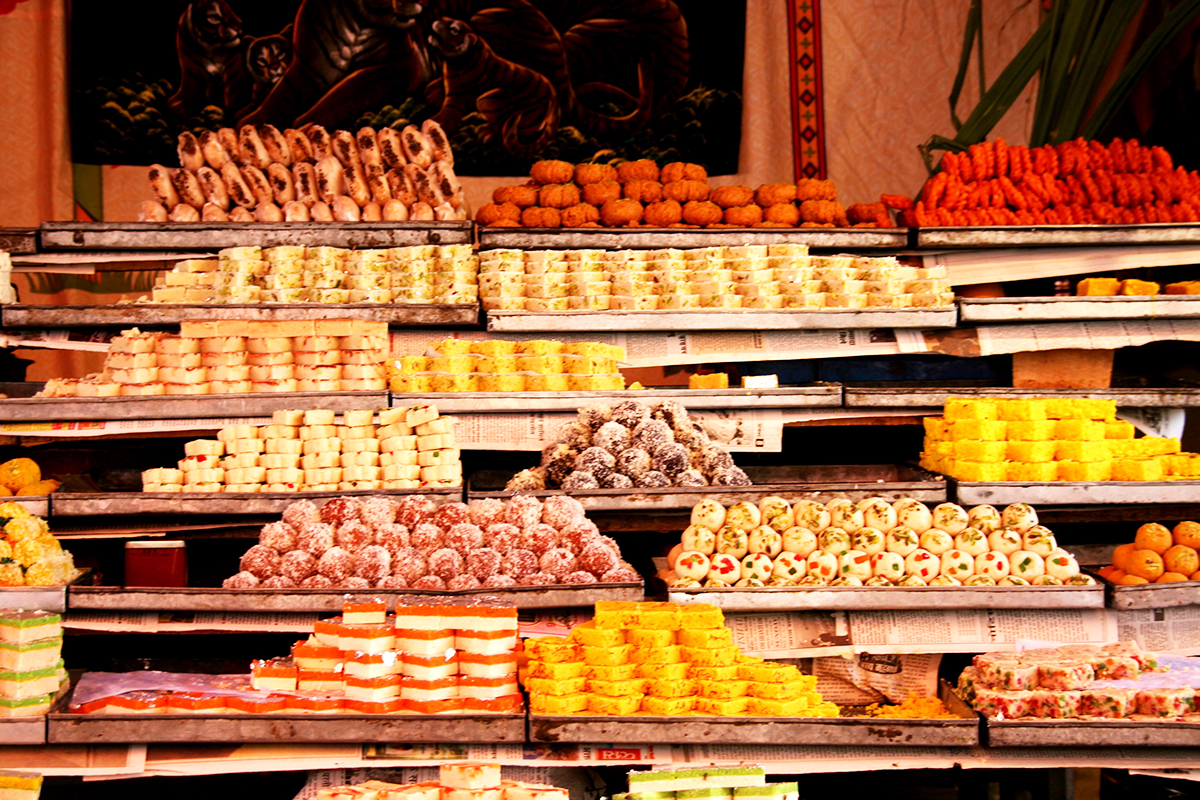
In one of those hopeful days of spring, a wall went up in the middle of Annapurna Mistanna Bhandar, bisecting the century-old sweetmeat outlet into two separate shops. While one reinvented itself as New Annapurna Mistanna Bhandar the other, probably hoping to sport a smarter avatar, chose to call itself New Annapurna Sweets.
Well, so far, so good. But Ratan, on his way to and from work, couldn’t help but be intrigued as to what could have engineered the split, and what lay in store for the two owners. Strangely, it was not merely the idle speculation of a fanciful mind but a kind of active and almost involuntary participation in the fluctuating fortunes of the new proprietors, close in bloodline and spatial proximity but separated by a column of plastered bricks.
While returning from office on certain days, Ratan stood undecided before the tempting twins, not sure which one to patronize. Well, if he ordered gulab jamuns from Santu’s well-stacked shelves Montu’s castigating look from the adjoining New Annapurna Sweets was sure to leave a bitter taste in the mouth. On the other hand, if he ventured to buy some sandesh from Montu he was certainly risking Santu’s piercing gaze boring into his back as he proceeded down the road. It was one of those niggling little things that made up the humdrum dilemmas of life and accosted Ratan’s sense of justice which always urged him to do the best by all.
Both shops put on a brave front and struggled manfully to stay afloat in the flotilla of local businesses in the ebbing tide of an economic downturn. If Santu spruced up his shop before the New Year, painting it a fetching shade of pink, Montu promptly followed suit, trying to outdo his cousin by daubing his walls with a lurid magenta. Or, if Montu did up his little domain with extra neon lights, thinking perhaps to brighten his fortunes through a fluorescent addition, Santu unwilling to have his lustre dimmed by any brazen act of neighbourly ostentation, had LED lights installed in his shop, never mind if the customers were in danger of being blinded by the strong glare.
And so it went in a game of not-so-subtle one-upmanship as the friends-turned-rivals vied with each other for delicious custom and patronage. As the tension between the two brewed, stewed or simmered according to the intensity of the gastronomical standoffs, the two establishments ran the gauntlet of equalizing encounters. One day, on an impulse, Montu put up a refurbished image of their patron deity, seeking to improve his fortunes through supernatural supplication. Santu, not to be caught lagging behind on any account, and certainly not in that of divine propitiation, immediately had a most expensive image of the same installed in a prominent alcove for all to see, Ratan was amused to note. Really! He shook his head in bemusement.
The sweets of the original shop used to be of a different vintage altogether. Or so the cognoscenti held. Ratan had been nurtured on a veritable diet of stories revolving around the legendary specialties of Annapurna Mistanna Bhandar. The cousins’ great-grandfather, locally known as Hiren Moira, used to source his chhana from Tarakeswar and its adjoining areas and his karigars used to be some of the best in the trade. Weddings, annaprasans, shraddhas in Ratan’s locality equally called for Hiren Moira’s confections.
While there was no denying the fact that the quality of the sweets had declined over the years, it had to be conceded that Hiren Moira’s heirs did try to keep up the tradition. The melt-in-the-mouth pranharas, slow-release jalbhoras, syrup-squirting kheerkodombos and crunchy kalojams, not to forget those ubiquitous spongy globes in their swirling, sugary seas, the rossogollas, the mainstay of both shops, were lapped up by locals and outliers alike.
One day, as Ratan was enjoying an adda with his group of neighborhood friends, he noticed that there was more than the customary knot of people outside Montu’s shop as opposed to a thin trickle before the adjoining one. Mahesh joked, “Maybe old Montu is lacing his stuff with alcohol.” “It’s possible. He’s drawing quite a crowd,’ chuckled Rajen.
Ratan soon discovered the reason. New Annapurna Sweets had just introduced a new concoction called ‘Shuddho Swad’ made from fresh coconut, condensed milk, sugar and sweet corn which had captured the tastebuds and imagination of consumers, and which explained the steady queue of patrons eager to try the debutante dessert.
Not to be outdone in this swashbuckling display of innovation on the high seas of entrepreneurship, and in a bid to win back any straying loyalist that may have migrated to the other side, Santu urged his chefs to come up with new ideas. It was not long before New Annapurna Mistanna Bhandar launched a rich riposte to its severed sibling. It was a chocolate, walnut and khoya affair with a pistachio garnish bearing the exotic name Flavorina. Revenge is sweet, they say.
And thus began the sweetmeat war. No outright attack on the enemy, no overt sabre-rattling, just tactical assaults and ambushes on the sense of taste of consumers who got to sample increasingly eclectic confections of uncertain lineage and patrician provenance, alike, propagated as ‘fusion’, ‘experimental’, ‘original’ and the like.
As unfamiliar tastes and flavours fought for supremacy on the tongues and nostrils of an unsuspecting clientele weaned on traditional recipes — gustatory attitudes, freed from their pristine, purist perch — began to roam the lanes and bylanes of alimentary adventure. Caught in the crossfire of the saccharine salvos unleashed during these guerilla offensives, patrons duly intercepted and relished the new delicacies, savouring the same on palates that were precociously developing into deeply discerning ones.
These so-called sweetmeat aficionados, drawn from various localities of the city, would nod knowingly over their chocolate patishaptas, blueberry curd or mango meringues, pursing their lips or crinkling their brows in concentration as they ran one or the other of these new-fangled concoctions over their tongues. Sandip Babu, an old-timer, would perhaps opine, “The consistency of the rice paste used in this patishapta is just right,” or Rajen would declare, “The blueberries have not been sourced from the authentic place,” his face grave with a connoisseur’s weighty wisdom.
Discreet loyalty lines were drawn up by the clientele who found themselves organised loosely into three groups. Some swore by New Annapurna Mistanna Bhandar’s well-researched creations while others couldn’t have enough of New Annapurna Sweets’ modern mélange. A few like Ratan oscillated between the two. This last group interestingly sported two affiliations. The first one consisted of rapacious reapers of sweet spinoffs frequenting both shops for the best deal while the members of the other felt duty bound to divide their custom equally between the parboiled peers out of a sense of judicious fairness. Yes, you have guessed correctly. Our Ratan belonged to this minority.
He wondered secretly why the cousins nursed acrimony and whether it was at all possible to put an end to it. A dark thought tugged at the corners of his heart. The house in which he had grown up, and now lived with his wife and caged parrot, too had been subject to divisions, partitions and shutting offs, the once vibrant life in it parcelled out in lopsided units of nuclear self-containment.
Well, whatever it was — it remained home sweet home, Ratan shrugged matter-of-factly.
As the years went by on the backs of blinding sun and slanting rain, relationships bloomed and withered and businesses flopped and prospered in the natural way of things. One morning, Ratan, on his way to office, noticed a difference. The shutters of New Annapurna Sweets were pulled fast, and the place wore a forlorn look. Ratan thought with a start as to what could have happened. Has it called it quits, then? Surely not!
Ratan learnt in due course that Montu, the proprietor of New Annapurna Sweets was severely ill. New Annapurna Mistanna Bhandar did not, as he expected, do roaring business, taking advantage of the situation. On the other hand, it wore a look of anxiety. Montu’s condition worsened and word was soon out that though he would pull through he would never be able to take up the reins of his business again.
Oh, that was sad. Ratan half-expected the temporarily closed shop to be swallowed up by its thriving doppelganger, and looked out for the imminent signboard proclaiming the cannibalistic merger. On the contrary, the two shops, one doing brisk business and the other closed, seemed to take on the aspect of a bifurcated being, paralyzed on one side, yet valiantly carrying on.
The situation carried on thus without anyone foreseeing a resolution in the near future. The fervour of coming up with gourmet inventions and strategic skirmishes along with the heady scent of success from victories scored had evaporated and were replaced by a rather staid and bland trade in sweetmeats unlaced with the zing and zest of culinary strife.
To his great surprise, however, in one of those hopeful days of spring, Ratan, while passing the erstwhile scene of fraternal feud, chanced upon a sight that warmed his heart. The wall demarcating the two separate sweetmeat shops had been pulled down to make a single store. Santu’s son and Montu’s daughter sat overseeing things in what appeared to be a joint arrangement in a single establishment. The bonhomie between the cousins, palpably present in the atmosphere, extended to the patrons as well who seemed to have heaved a collective sigh of relief, affiliations stowed away in the attic of the mind.
What is more, the very products on offer seemed visibly relaxed, freed of the tensions of cross-border conflict and internecine rivalries. This was no uneasy truce between wary contenders if the camaraderie between the fifth-generation heirs was anything to go by. In the days that followed, alliances came to be arranged between the sweetmeats dynasties of the two erstwhile rivals by their doting creators and the intermarriages that followed spawned offspring of varied shape and hue, not to mention taste.
The ledikenis threw off the colonial yoke of their historical christening and became proudly assertive in their deliciously darker aspect; the rossogollas, tinged with nolen gur contributed to the ‘nativist’ narrative, no less; the rasamalai became richer in its creamier texture while the chamchams multiplied in mouthwatering varieties of delight. There were the malai chamchams, their kheer counterparts, the badam ones, the kesar offshoots and so on in a delectable proliferation of generic improvisations.
The shop under its new leadership and the generational change underwent a makeover subsuming the discordant hues that had come to characterize the feuding fiefdoms into a perfectly peaceful shade of white plastic emulsion in which coexisted the potential shades of the prismatic spectrum.
The shop, in fact, reinvented itself as a market leader, regaining some of its earlier glory. It began to think of positioning itself as a national brand. It even reached out to the less privileged by instituting a free food counter for them. The problem of name, too, was amicably solved with both parties readily agreeing to the name Annapurna Sweets. It was short and sweet, they claimed by way of justification.
The reunification heralded a sweet promise to all concerned, perhaps the sweeter for its sheer unexpectedness. Now, time alone would be able to tell whether the shop would succeed in living up to its name, dispensing nourishment with the golden ladle of its provident patron deity, thought Ratan, the ever-skeptical, though well-meaning observer.
(This story was part of April issue, which was delayed due to the pandemic and released in July)
More from The Byword
Comments
*Comments will be moderated











